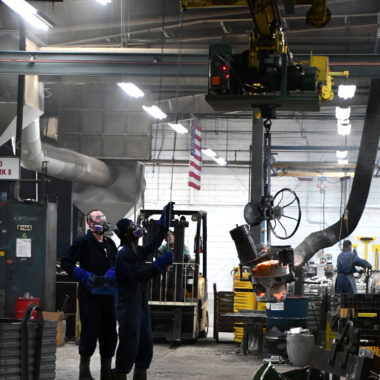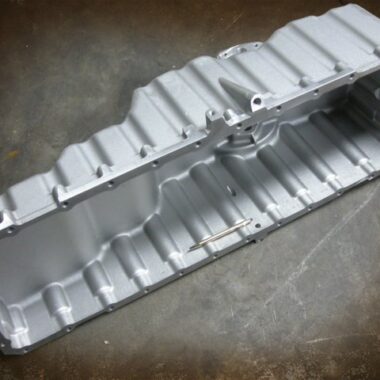Grasping Aluminum Casting: Proven Techniques to Boost Manufacturing Efficiency
Grasping Aluminum Casting: Proven Techniques to Boost Manufacturing Efficiency
Blog Article
Learning Light Weight Aluminum Spreading: a Deep Study the Various Strategies Available
Aluminum casting stands as a foundation of modern manufacturing procedures, providing versatility and precision in generating useful parts and detailed styles. As sectors significantly turn to aluminum for its lightweight yet resilient properties, understanding the various spreading methods ends up being paramount. From the conventional technique of sand casting to the facility processes of financial investment spreading and pass away spreading, each strategy presents special obstacles and advantages. Understanding the subtleties of these approaches is essential for making sure the quality and performance of the spreading procedure. In this expedition of light weight aluminum casting techniques, we will drop light on the ins and outs of each approach, giving insights that could transform your strategy to aluminum spreading.

Sand Spreading Technique Overview
The Sand Spreading method's flexibility and extensive application make it a cornerstone in mastering aluminum spreading procedures. This method entails producing a mold and mildew from a mixture of sand and a binder, such as clay, to form intricate forms for casting liquified light weight aluminum. Sand spreading is a prominent option as a result of its reasonably affordable, ease of adjustment, and ability to create complicated geometries with high accuracy.
The procedure starts with the creation of a pattern, normally made of wood or steel, which is pressed right into the sand to produce a mold cavity. When the pattern is gotten rid of, the mold dental caries is loaded with liquified light weight aluminum, which strengthens to take the form of the pattern. After cooling down and solidification, the sand mold is broken away, disclosing the aluminum casting.
Sand spreading is commonly made use of in various industries, consisting of automobile, aerospace, and production, as a result of its versatility in creating both little and large light weight aluminum components (aluminum casting). Its versatility to elaborate layouts and cost-effectiveness make it a recommended option for several light weight aluminum spreading applications
Permanent Mold And Mildew Casting Process Described
Discovering the details of light weight aluminum spreading, the Long-term Mold Casting process provides a refined method for creating high-quality parts with accuracy and performance. Unlike sand casting, long-term mold spreading makes use of a multiple-use mold usually made of steel or iron to shape the liquified aluminum.
Irreversible mold spreading can be classified into 2 major types: gravity casting and low-pressure spreading. Gravity spreading involves pouring the molten metal into the mold and mildew making use of gravity, while low-pressure casting utilizes reduced stress to fill the mold and mildew dental caries. Both techniques provide benefits in regards to decreasing porosity and improving mechanical properties.
Die Casting: Downsides and advantages
Understanding the ins and outs of die casting entails comprehending its distinctive advantages and disadvantages in the world of aluminum element production. Pass away casting offers a number of benefits that make it a prominent choice for creating aluminum parts. One vital advantage is the high-speed production ability of die spreading, enabling the mass manufacturing of complicated forms with tight resistances. In addition, die casting gives outstanding dimensional precision and smooth surface finishes, lowering the need for extra machining procedures. The process is likewise very repeatable, guaranteeing regular quality across big production runs.
Nevertheless, pass away spreading does Full Article feature its very own set of negative aspects. One major drawback is the high initial tooling expense related to creating the dies used while doing so (aluminum casting). These molds can be costly to create, making pass away casting much less affordable for tiny manufacturing runs. Moreover, the process is not as flexible when it comes to develop changes compared to other casting methods like sand casting. In spite of these restrictions, the advantages of die casting frequently outweigh the disadvantages, making it a preferred selection for several light weight aluminum spreading applications.
Investment Casting Benefits and applications
Building on the benefits of die spreading, investment casting supplies a functional technique for producing elaborate aluminum parts with unique advantages in numerous applications. Investment casting, likewise called lost-wax casting, succeeds in developing complicated forms that would be difficult or impossible to accomplish through other approaches. This technique is extensively utilized in industries such as aerospace, vehicle, and fashion jewelry making.
One of the key benefits of financial investment casting is its capacity to produce near-net form parts, lessening the need for extra machining and reducing material waste. This causes cost savings and faster manufacturing times compared to standard machining procedures. Furthermore, investment spreading permits the production of get rid of exceptional surface coatings and limited resistances.
In the aerospace market, investment casting is preferred for its capability to produce lightweight yet strong components vital for airplane performance. The automotive industry benefits from investment casting for producing elements with high dimensional precision and complex styles. Generally, investment spreading uses a Look At This cost-efficient and specific remedy for making elaborate light weight aluminum components throughout various markets.

Lost Foam Spreading: Exactly How It Functions
Shed foam spreading, also called evaporative-pattern casting, is an approach for developing detailed metal components by using foam patterns that evaporate during the spreading procedure. This strategy begins with a foam pattern of the preferred part being put into unbonded sand. The foam pattern is typically covered with a refractory material to boost the you can try here surface finish of the last metal part. When molten metal is poured into the mold and mildew, the foam evaporates due to the warmth, leaving a cavity that is after that filled up by the metal.
One of the essential benefits of shed foam spreading is its capability to create complex forms with elaborate details that may be testing to attain with other casting methods. Additionally, the process can be affordable as it gets rid of the demand for cores and permits the debt consolidation of numerous components right into a solitary component. It requires mindful control of the process specifications to make certain proper foam vaporization and metal circulation.
Conclusion
In final thought, grasping aluminum spreading entails understanding and utilizing various techniques such as sand spreading, long-term mold spreading, die casting, financial investment casting, and shed foam casting. Each technique has its own advantages and applications in the production procedure. By acquainting oneself with these different techniques, manufacturers can pick one of the most suitable casting strategy for their specific demands and demands, eventually bring about effective and successful production of aluminum components.
From the standard method of sand spreading to the complicated processes of financial investment casting and pass away casting, each strategy provides unique obstacles and advantages. In this expedition of aluminum spreading techniques, we will certainly shed light on the details of each approach, giving insights that could change your technique to light weight aluminum spreading.

Report this page